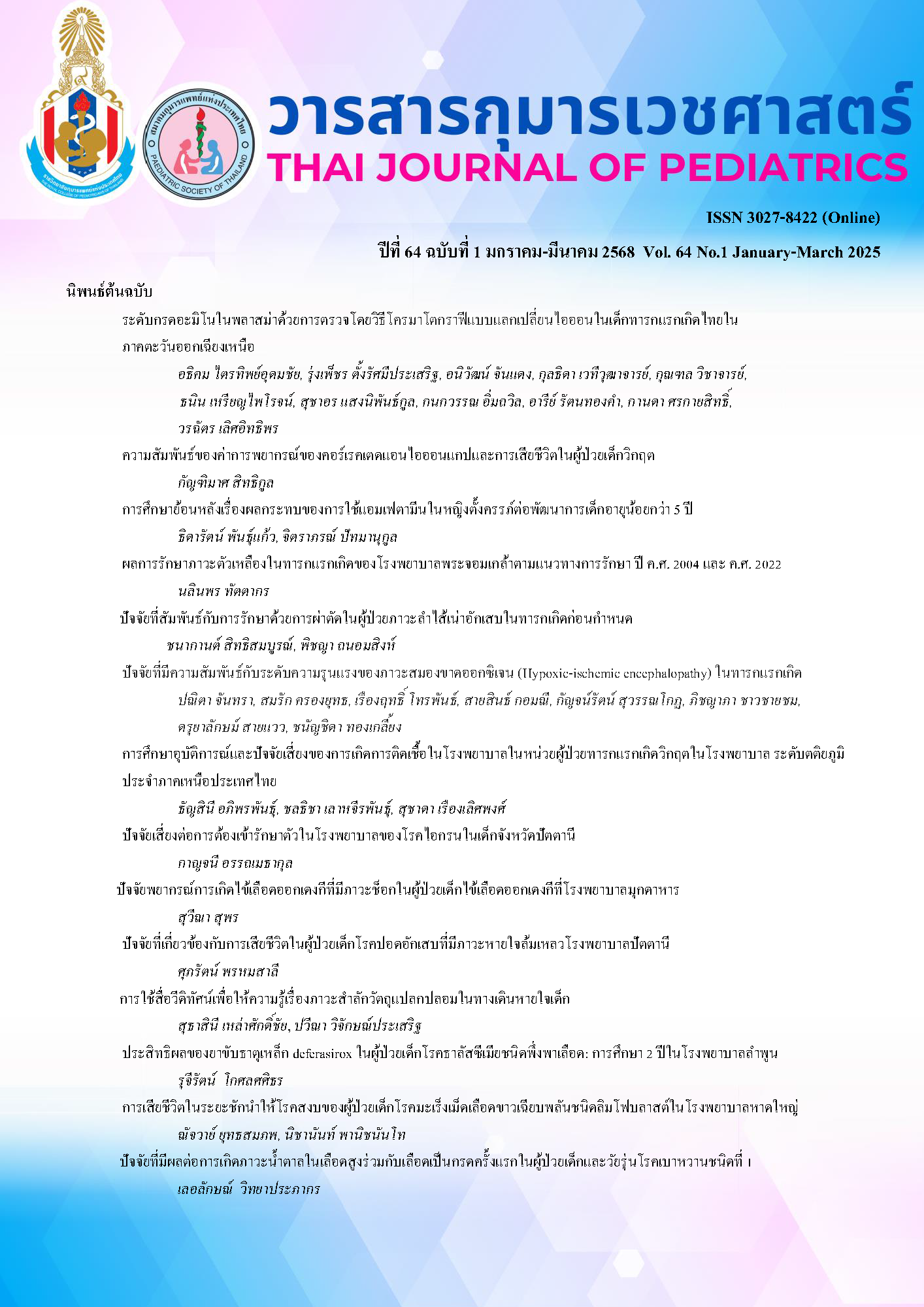การศึกษาอุบัติการณ์และปัจจัยเสี่ยงของการเกิดการติดเชื้อในโรงพยาบาลในหน่วยผู้ป่วยทารกแรกเกิดวิกฤตในโรงพยาบาลระดับตติยภูมิประจำภาคเหนือประเทศไทย
คำสำคัญ:
การติดเชื้อในโรงพยาบาล, หอผู้ป่วยทารกแรกเกิดภาวะวิกฤต, ปัจจัยเสี่ยง, การติดเชื้อในกระแสเลือด, ภาวะทุพพลภาพบทคัดย่อ
ความเป็นมา: การติดเชื้อในโรงพยาบาล (healthcare associated infection, HAI) เป็นภาวะแทรกซ้อนที่สามารถพบได้บ่อยในทารกที่ได้รับการรักษาในหอผู้ป่วยทารกแรกเกิดวิกฤต ซึ่งเป็นสาเหตุสำคัญประการหนึ่งที่เพิ่มภาวะทุพพลภาพและอัตราการเสียชีวิตให้แก่ทารกที่เข้ารับการรักษา
วัตถุประสงค์: เพื่อศึกษาอุบัติการณ์การติดเชื้อในโรงพยาบาล ปัจจัยเสี่ยงที่สัมพันธ์กับการติดเชื้อในโรงพยาบาล และ รูปแบบของเชื้อก่อโรคที่ทำให้เกิดการติดเชื้อในโรงพยาบาลของทารกแรกเกิดที่เข้ารับการรักษาในหอผู้ป่วยทารกแรกเกิดวิกฤต
วิธีการศึกษา: การศึกษานี้เป็นการศึกษาวิจัยแบบเก็บข้อมูลไปข้างหน้าระยะเวลา 1 ปี เก็บข้อมูลในทารกที่เข้ารับการรักษาในหอผู้ป่วยทารกแรกเกิดวิกฤต ตั้งแต่วันที่ 20 สิงหาคม พ.ศ. 2566 จนถึง 20 สิงหาคม พ.ศ. 2567
ผลการศึกษา: งานวิจัยนี้มีกลุ่มตัวอย่างทั้งหมด 624 ราย โดยพบการติดเชื้อในโรงพยาบาลจำนวน 107 ครั้งเหตุการณ์ คิดเป็นอุบัติการณ์ร้อยละ 17.2 ปัจจัยเสี่ยงที่สัมพันธ์กับการติดเชื้อในโรงพยาบาล ได้แก่ ภาวะขาดออกซิเจนปริกำเนิด (คะแนนแอพการ์ ที่ 5 นาทีน้อยกว่า 7) (aHR 2.44, p value 0.03), การใส่สายสวนหลอดเลือดดำทางสะดือมากกว่า 7 วัน (aHR 1.88, p value 0.04) และระยะเวลาในการนอนโรงพยาบาลที่เพิ่มขึ้น (aHR 0.97, p value 0.02) ประเภทการติดเชื้อที่พบมากที่สุด ได้แก่ การติดเชื้อในกระแสเลือดแบบปฐมภูมิ (primary bloodstream infection) ร้อยละ 35.5 ปอดอักเสบจากการใช้เครื่องช่วยหายใจ (ventilator associated pneumonia, VAP) ร้อยละ 22.4 และการติดเชื้อในกระแสเลือดที่สัมพันธ์กับสายสวนหลอดเลือดดำส่วนกลาง ร้อยละ 17.8 โดยไม่พบเชื้อก่อโรคที่เป็นสาเหตุ ร้อยละ 55.1 ในกรณีพบเชื้อ เชื้อก่อโรคที่เป็นสาเหตุการติดเชื้อในโรงพยาบาลมากที่สุด คือ Acinetobacter baumannii ร้อยละ 24.3 coagulase-negative Staphylococcus ร้อยละ 7.5 และ Escherichia coli ร้อยละ 3.1
สรุป: อุบัติการณ์การติดเชื้อในโรงพยาบาลในทารกที่เข้ารับการรักษาในหอผู้ป่วยทารกแรกเกิดวิกฤตพบร้อยละ 17.2
Downloads
เอกสารอ้างอิง
Sass L, Karlowicz MG. Healthcare-associated infections in the neonate. Principles and Practice of Pediatric Infectious Diseases. 2018;560-6.e3.
Stoll BJ, Hansen N, Fanaroff AA, Wright LL, Carlo WA, Ehrenkranz RA, et al. Late-onset sepsis in very low birth weight neonates: The experience of the NICHD neonatal research network. Pediatrics. 2002;110:285–91.
Choobdar F, Vahedi Z, Khosravi N, Khalesi N, Javid A, Shojaee S. Nosocomial infection in an Iranian neonatal intensive care unit: hospital epidemiology and risk factors. Arch Pediatr Infect Dis. 2020;11:8.
Kumar S, Shankar B, Arya S, Deb M, Chellani H. Healthcare associated infections in neonatal intensive care unit and its correlation with environmental surveillance. J Infec Pub Health. 2018;11:275–9.
Vain NE, Farina D, Vazquez LN. Neonatology in the emerging countries: the strategies and health-economics challenges related to prevention of neonatal and infant infections. Early Hum Dev. 2012;88:S53–9.
Demirdag BT, Koc E, Tezer H, Oguz S, Satar M, Saglam O, et al. The prevalence and diagnostic criteria of health-care associated infections in neonatal intensive care units in Turkey: A multicenter point- prevalence study. Pediatr Neonatol. 2021;62:208–17.
Dramowski A, Aucamp M, Beales E, Bekker A, Cotton MF, Fitzgerald FC, et al. Healthcare-associated infection prevention interventions for neonates in resource-limited settings. Frontiers in pediatrics. 2022;7:10.
Orsi GB, d’Ettorre G, Panero A, Chiarini F, Vullo V, Venditti M. Hospital-acquired infection surveillance in a neonatal intensive care unit. Am J Infec Control. 2009;37:201–3.
Auriti C, Ronchetti MP, Pezzotti P, Marrocco G, Quondamcarlo A, Seganti G, et al. Determinants of nosocomial infection in 6 neonatal intensive care units: An Italian multicenter prospective cohort study. Infection control & hospital epidemiology. 2010;31:926–33.
Leksakundilok P, Leksakundilok J, Ounchanum P. Incidence of ventilator-associated pneumonia in preterm very low birth weight neonates with positive tracheal aspirate cultures. วารสารกุมารเวชศาสตร์. 2565;61:172-9.
Wright MO, Hebden JN, Allen-Bridson K, Morrell GC, Horan T. Healthcare-associated infections studies project: An American journal of infection control and national healthcare safety network data quality collaboration. Am J Infec control. 2010;38:416–8.
CDC/NHSN surveillance definitions for specific types of infections [Internet]. 2020. [cited 2022 Oct 30] Available from: https://www.cdc.gov/nhsn/pdfs/pscmanual/17pscnosinfdef_current.pdf
Centers for Disease Control and Prevention. Catheter-associated urinary tract infection (CAUTI) [Internet]. 2024. [cited 2022 Oct 30] Available from: https://www.cdc.gov/nhsn/pdfs/ pscmanual/ 7psccauticurrent.pdf
Jeong IS, Jeong JS, Choi EO. Nosocomial infection in a newborn intensive care unit (NICU), South Korea. BMC Infect Dis. 2006;33:686-92.
Zheng X, He D, Yang Z, Chen L, Jiang M, Qi Y, et al. Dwell time and bloodstream infection incidence of umbilical venous catheterization in China. Pediatr Investig. 2023;7:239-46.
Corso L, Buttera M, Candia F, Sforza F, Rossi K, Lugli L, et al. Infectious risks related to umbilical venous catheter dwell time and its replacement in newborns: A narrative review of current evidence. Life. 2024;13:123.
Petdachai W. Nosocomial pneumonia in a newborn intensive care unit. J Med Assoc Thai. 2000;83:392-7.
Ibrahim S, Al-Saryi N, Al-Kadmy IMS, Aziz SN. Multidrug-resistant Acinetobacter baumannii as an emerging concern in hospitals. Mol Biol Rep. 2021;48:6987-98.
ดาวน์โหลด
เผยแพร่แล้ว
รูปแบบการอ้างอิง
ฉบับ
ประเภทบทความ
สัญญาอนุญาต
ลิขสิทธิ์ (c) 2025 ราชวิทยาลัยกุมารแพทย์แห่งประเทศไทย และ สมาคมกุมารแพทย์แห่งประเทศไทย

อนุญาตภายใต้เงื่อนไข Creative Commons Attribution-NonCommercial-NoDerivatives 4.0 International License.


